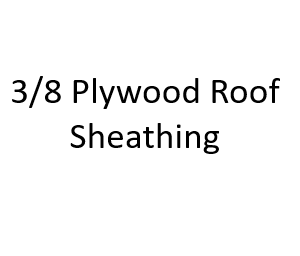When it comes to roofing materials, plywood sheathing plays a critical role in providing structural support and ensuring the longevity of your roof. One option that has gained popularity is 3/8-inch plywood roof sheathing. In this blog post, we’ll dive into the world of 3/8 plywood roof sheathing and explore its advantages, applications, and why it might be the right choice for your roofing project.
Understanding 3/8 Plywood Roof Sheathing
Plywood roof sheathing is an essential component of any roofing system. It serves as the base layer onto which other roofing materials, such as shingles or metal roofing, are installed. The “3/8” in 3/8 plywood roof sheathing refers to the thickness of the plywood sheets. While there are various thickness options available, 3/8-inch plywood is a popular choice for several reasons.
Advantage 1: Lightweight and Cost-Effective
One of the primary advantages of it is its lightweight nature. Compared to thicker plywood options, 3/8-inch plywood is easier to handle during installation. This can save both time and labor costs, making it a cost-effective choice for roofing projects, especially for those on a budget.
Advantage 2: Flexibility and Easy Installation
3/8-inch plywood is more flexible than thicker alternatives, allowing it to conform to the contours of your roof more easily. This flexibility is particularly beneficial when dealing with uneven or irregular roof structures. Its ease of installation can also lead to faster project completion, reducing overall labor expenses.
Advantage 3: Adequate Strength and Durability
While 3/8 plywood roof sheathing is thinner than some alternatives, it still offers sufficient strength and durability for most residential roofing applications. It can withstand the weight of roofing materials, such as shingles or tiles, and provide reliable support for the entire roofing system. However, it’s essential to ensure proper installation and follow manufacturer guidelines for maximum longevity.
Advantage 4: Reduced Dead Load
The weight of roofing materials can contribute significantly to the overall load on a building’s structure. Thicker plywood sheathing options can increase this dead load. 3/8-inch plywood is a lighter option, reducing the stress on the building’s framework and potentially extending its lifespan.
Advantage 5: Suitable for Re-Roofing Projects
In some cases, homeowners may opt for re-roofing rather than a complete roof replacement. 3/8 plywood roof sheathing is an excellent choice for re-roofing projects where the existing structure can support the new roofing materials. Its lightweight and flexibility make it easier to work with in these scenarios.
Applications:
Now that we’ve explored the advantages of 3/8-inch plywood roof sheathing, let’s consider its applications:
- Residential Roofing: 3/8 plywood roof sheathing is commonly used in residential roofing projects. Its affordability and versatility make it a suitable choice for homes with standard roof structures.
- Shingle Roofing: This type of sheathing works well with asphalt shingle roofing, a popular choice for residential properties. It provides a stable base for the shingles and helps ensure a long-lasting roof.
- Re-Roofing: When re-roofing a home, 3/8 plywood roof sheathing can be an ideal option if the existing structure can support it. It simplifies the re-roofing process and reduces the additional load on the building.
- Roof Repair: If you’re only replacing a portion of your roof, 3/8-inch plywood can seamlessly integrate with the existing sheathing, providing consistent support.
Additional Considerations:
1. Climate and Weather Conditions: Before selecting 3/8 plywood roof sheathing, it’s crucial to consider your local climate and weather conditions. If you live in an area with heavy rainfall, snow loads, or extreme temperature fluctuations, you may need to opt for thicker sheathing for added durability and insulation.
2. Roof Ventilation: Proper roof ventilation is essential for preventing moisture buildup and ensuring the longevity of your roofing materials. When using 3/8 plywood roof sheathing, pay extra attention to ventilation to mitigate potential moisture issues.
3. Compliance with Building Codes: Always check local building codes and regulations to ensure that 3/8-inch plywood meets the minimum requirements for your roofing project. Some regions may have specific guidelines regarding sheathing thickness based on factors like climate and structural considerations.
Tips for Using 3/8 Plywood Roof Sheathing:
1. Hire a Professional: Roofing projects can be complex, and the choice of sheathing material is just one aspect. It’s advisable to consult with a professional roofing contractor who can assess your specific needs and provide expert guidance.
2. Inspect the Existing Structure: If you’re re-roofing or performing roof repairs, thoroughly inspect the existing sheathing and structure to ensure it’s in good condition. Any damaged or deteriorated sheathing should be replaced before installing new material.
3. Follow Manufacturer Guidelines: Manufacturers provide specific guidelines for the installation of plywood roof sheathing. It’s essential to follow these instructions carefully to ensure a secure and long-lasting roof.
4. Proper Fastening: Use the recommended fasteners and spacing as specified by the manufacturer. Properly fastening the plywood sheathing is crucial for structural integrity and preventing issues like roof sagging.
5. Consider Roof Underlayment: In addition to plywood sheathing, consider using a high-quality roof underlayment. Underlayment provides an additional layer of protection against moisture and can enhance the overall performance of your roof.
6. Regular Maintenance: Once your roof is in place, perform regular maintenance to keep it in optimal condition. Inspect for signs of wear and tear, check for leaks, and ensure that your roof continues to provide the protection your home needs.
Conclusion:
3/8 plywood roof sheathing is a practical choice for many residential roofing projects, offering a balance between cost-effectiveness and performance. By considering your specific needs, climate, and adhering to best practices during installation, you can make the most of this versatile roofing material. Always consult with professionals when necessary to ensure that your roofing project is a success, providing you with a durable and reliable roof for years to come.
